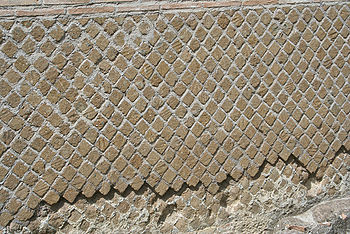
Opus reticulatum
Encyclopedia

Brickwork
Brickwork is masonry produced by a bricklayer, using bricks and mortar to build up brick structures such as walls. Brickwork is also used to finish corners, door, and window openings, etc...
used in ancient Roman architecture
Roman architecture
Ancient Roman architecture adopted certain aspects of Ancient Greek architecture, creating a new architectural style. The Romans were indebted to their Etruscan neighbors and forefathers who supplied them with a wealth of knowledge essential for future architectural solutions, such as hydraulics...
. It consists of diamond
Diamond
In mineralogy, diamond is an allotrope of carbon, where the carbon atoms are arranged in a variation of the face-centered cubic crystal structure called a diamond lattice. Diamond is less stable than graphite, but the conversion rate from diamond to graphite is negligible at ambient conditions...
-shaped bricks of tuff
Tuff
Tuff is a type of rock consisting of consolidated volcanic ash ejected from vents during a volcanic eruption. Tuff is sometimes called tufa, particularly when used as construction material, although tufa also refers to a quite different rock. Rock that contains greater than 50% tuff is considered...
placed around a core of opus caementicium. The diamond-shaped tufa blocks were placed with the pointed ends into the cement
Cement
In the most general sense of the word, a cement is a binder, a substance that sets and hardens independently, and can bind other materials together. The word "cement" traces to the Romans, who used the term opus caementicium to describe masonry resembling modern concrete that was made from crushed...
core at an angle of roughly 45 degrees, so the square
Square (geometry)
In geometry, a square is a regular quadrilateral. This means that it has four equal sides and four equal angles...
bases
Bases
Bases may refer to:*Bases , a military style of dress adopted by the chivalry of the sixteenth century.*Business Association of Stanford Entrepreneurial Students...
formed a diagonal pattern, and the pattern of mortar lines resembled a net. Reticulatum is the Latin term for net, and opus, the term for a work of art, thus the term translates to "net work".
This construction technique was used from the beginning of the 1st century BC, and remained very common until opus latericium
Opus latericium
thumb|250px|Example of opus latericium on a tomb of the ancient [[Appian Way]] in [[Rome]].Opus latericium is an ancient Roman form of construction in which coarse-laid brickwork is used to face a core of opus caementicium....
, a different form of brickwork, became more common.
Opus reticulatum was used as a technique in the Renaissance Palazzo Rucellai
Palazzo Rucellai
Palazzo Rucellai is a palatial 15th century townhouse on the Via della Vigna Nuova in Florence, Italy. The Rucellai Palace is believed by most scholars to have been designed by Leon Battista Alberti between 1446 and 1451 and executed, at least in part, by Bernardo Rossellino...
in Florence
Florence
Florence is the capital city of the Italian region of Tuscany and of the province of Florence. It is the most populous city in Tuscany, with approximately 370,000 inhabitants, expanding to over 1.5 million in the metropolitan area....
, the skill having been lost with the end of the Roman Empire, and rediscovered by means of archeology by Leon Battista Alberti.
The initial, rough form of opus reticulatum, an advancement from opus incertum, is called opus quasi reticulatum.
See also
- Opus incertumOpus incertumthumb|280px|Layers of opus incertum on the left side of the Temple of Iovis Anxur in [[Terracina]], [[Italy]].Opus incertum was an ancient Roman construction technique, using irregular shaped and random placed uncut stones or fist-sized tuff blocks inserted in a core of Opus caementicium.Initially...
- Opus compositum
- Opus caementicium
- Roman concreteRoman concreteRoman concrete was a material used in construction during the late Roman Republic through the whole history of the Roman Empire. Roman concrete was based on a hydraulic-setting cement with many material qualities similar to modern Portland cement...

